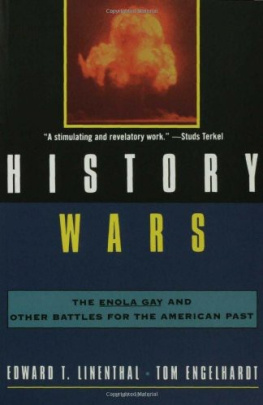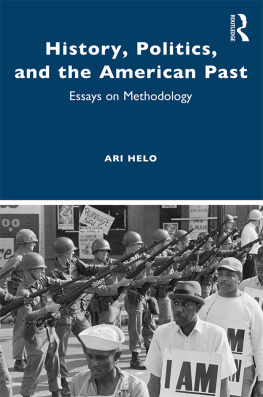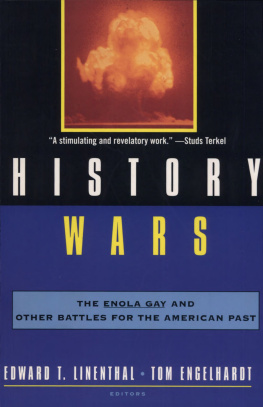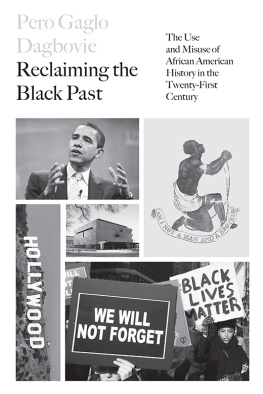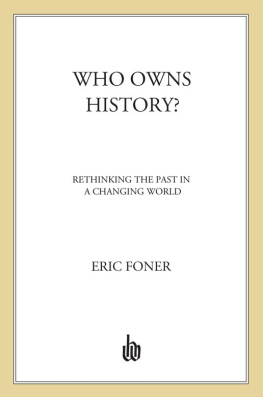TOM ENGELHARDT AND
EDWARD T. LINENTHAL
O n November 23, 1994, National Public Radios Morning Edition informed its listeners that one of the iconic artifacts of World War II had arrived at the Smithsonian Institutions National Air and Space Museum on the Mall in Washington, D.C. At about a quarter to one, under a cloud-covered moon, the reporter began, four police cars cruised down Independence Avenue, escorting what looked almost like a float in the Macys Thanksgiving Day Parade. A flatbed truck carried a huge tube more than fifty feet long, wrapped in what seemed to be white plastic. The tube was the front half of the plane that carried the bomb that killed thousands of Japanese on August 6, 1945.
Here, under wraps, was the imposing fuselage of the Enola Gay , the famed B-29 Superfortress that dropped the first atomic bomb on Hiroshima. The aircraft, credited by many with ending a war of unparalleled ferocity, saving countless American lives, and bringing peace to a war-weary world, was now to rest temporarily in the museum that displayed the Wright brothers first plane, Charles Lindberghs ocean-spanning Spirit of St. Louis , and the Apollo spacecraft that brought humans to the moon.
Even though it entered the museum in the dead of night, the Enola Gay was shadowed by another story of wars end. For National Public Radios reporter pointed out that the aircrafts route to the museum was not deserted. One protester sang a song of the hibakusha, those who had survived the atomic bomb the Enola Gay dropped on Hiroshima (a national peace song in Japan, the reporter noted). Elsewhere en route, demonstrators from the pacifist Catholic Worker movement unfurled a banner that read Disarm.
For fifty years, these two storiesof a weapon that brought peace and victory, and of a weapon that brought destruction and fear to the worldrested uneasily in American consciousness. Now, the aircrafts fuselage was headed toward an exhibit that promised to bring those two narratives together in a single museum space. With the plane as its central icon, that show was to explore the end of a hot war and the beginning of a cold one. As conceived by the Smithsonians curators and advisers, the exhibit was to examine the bombs creation, the decision to use it against Japanese cities, the Enola Gay s mission, the ground-level effects of atomic weaponry, the bombs role in ending the war, and the new era it inauguratedas well as the ways in which decades of historical research and debate on these topics had altered and deepened our understanding of them.
Such an exhibition, however, was not to be. For months, after a draft script of the proposed show was released to the media by the Air Force Association, a military lobbying group, the Smithsonians managers and curators as well as the historians on whom they relied were subjected to increasingly angry charges: they had hijacked history; they were anti-American; they were practicing politically correct curating; they were projecting the countercultural values of the Vietnam era onto Americas last good war. The fierceness of this response eventually doomed the National Air and Space Museums planned show amid a remarkable controversy that pitted museum curators and historians against military officials and veterans lobbying groups, as well as much of the media and Congress.
The exhibit was abandoned by a humiliated museum administration in January 1995 (to be replaced by a blandly upbeat display of the Enola Gay itself). Meanwhile, there were surprisingly few other memorial festivities celebrating the fiftieth anniversary of World War IIs endthe greatest military victory in U.S. historyeven if the final moments of that war were anything but dead in public memory. In fact, it soon became apparent that they still held a rawness startling for events so long past. A oncefamiliar triumphant tale of a victory over Germany and Japan that was to lead to an American Century now seemed to end in disarray on August 6, 1945, in the rubble of Hiroshima. As August 6, 1995, approached, Peter Jennings anchored an ABC television documentary questioning the decision to drop the bomb, while Ted Koppel defended that decision on the same networks Nightline . Countless talk-radio programs, magazine and news articles, editorials, books, and book reviews argued over the minutiae of policymaking in 1945 with a passion and vitriol more often associated with fast-breaking news; and increasingly upset World War II veterans struggled to reassert to an oddly resistant nation the victory story they believed was their due.
Even with August 1995 past, anger about the Enola Gay exhibit did not die. On September 25, for instance, Robert Dole, Senate Majority Leader, Republican presidential hopeful and World War II veteran, made a pilgrimage to Indianapolis to address the national convention of the American Legion. His right arm and shoulder shattered by an explosive shell in Italy half a century earlier, the seventy-one-year-old Dole stood before the Legionnairesmany of them also aging survivors of his waron what he was calling his final mission.
As undoubtedly the last member of that wartime generation to seek the presidency, he had the war on his mindand not just because he had been reminding the media of his old injury (partly as a rebuke to a young Democratic president long accused of being a draft dodger). Facing an audience of sympathetic veterans fifty years after the Japanese signed the instruments of surrender, Senator Dole did not linger on positive memories of a war that had once unified America in righteous victory. Instead, after the briefest of surveys of dark forces multiplying in almost every corner of the world from North Korea to Iraq, he launched a frontal attack on Americas true enemies in a postEvil Empire world: the arbitrators of political correctness, government and intellectual elites who seem embarrassed by America, and educators and professors engaged in a shocking campaign to disparage America and destroy the keys to American unity, its language, history, and values.
He proceeded to attack diversity, multilingualism, affirmative action, and the newly proposed national history standards (whose purpose, he said, was to denigrate Americas story while sanitizing and glorifying other cultures). Then, perhaps in search of a little red meat to add to his stump speech diet, he decried the fact that liberal academic elites control more than our schools, and began to gnaw on the proposed Enola Gay exhibit, now nine months dead, that had already nourished Pat Buchanan, Newt Gingrich, Rush Limbaugh, and so many other conservative and right-wing politicians and media commentators.
The Smithsonian created a display to commemorate the anniversary of Hiroshima, the day we effectively won a global war against the forces of evil, he said indignantly. The message was that the dropping of the bomb was an act of American violence against Japanese culture. Somehow the Japanese were painted not as the aggressors but as the victims of World War II. Veterans groups like the American Legion that complained were dismissed as special interests who couldnt be objective. Thats right, he added after a pregnant pause, if you love this country so much youre willing to die for it, maybe you do belong to a special interest, but that special interest used to be called the people of the United States of America.
The fiftieth anniversary of any major event that put large numbers of people in peril naturally tends to establish a protective membrane around the commemorative moment. This accounts, in part, for the outrage that Senator Dole and other veterans expressed over the possibility that Americas preeminent national museum might display historical material complicating or questioning more glorious tales of World War IIs end. At the same time, however, Senator Doles comments also reflected familiar themes in recent Republican party politics. After all, appeals to traditional values and attacks on the elitist, liberal media, the politically correct, and the racially other for supposedly undermining those values (as well as desecrating once-popular American conceptions of the past) have done much to keep the various factions of the party together.

